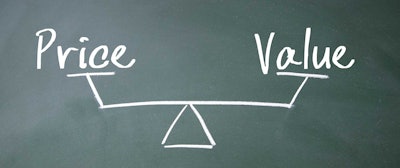
Although buyers object on price, there is another reason they’re not buying. Buyers tell you they don’t have the budget or your product is just too expensive. Buyers object on price because it’s less personal. The buyer would rather say, “Your price is too high” than “You haven’t sold me on the value.” Price objections are easier to accept because they are less personal.
Salespeople take price objections at face value. Just because a buyer gives you a price objection doesn’t mean your price is too high. Maybe your value is too low. Buyers object on price when they aren’t sold on your value. If the buyer doesn’t see the value in your solution, the price is always going to be high.
A perceived lack of equity is the number one reason buyers object on price. A solution is inequitable when there is a gap between price and value. There are two ways to close this gap—lower the price, or increase value. Seventy-five percent of salespeople discount to close this gap. There is another option… What if you increased your value instead of discounting your price?
Here are some ideas to close the gap without discounting.
Clarify
The first step is clarifying the objection. When the buyer gives you a price objection, ask for more information. This is called a clarifying question. A clarifying question forces the buyer to elaborate on their response. A clarifying question reveals the root cause of the objection.
Add Value
Most price resistance is due to a perceived lack of equity. Increasing your value will help you close the gap without discounting. You can add value in several different ways. Your best bet is to ask the buyer.
You might say to the buyer, “It appears you feel there is a gap between the price you’re paying and the value you are receiving. Let’s discuss some ways we can close this gap. What can we do to increase the value of our solution?”
Value Reinforcement
In certain cases, the buyer forgets about the value you bring. Existing customers take your value for granted and forget. If the buyer forgets your value, your price is too high. Existing customers are the most susceptible. These buyers don’t need more value, they need to be reminded of the value you have already created.
You might say to the buyer, “It appears you feel there is a gap between the price you’re paying and the value you are receiving. Let’s discuss some of the ways our value-added solution has helped your business over the past year.”
 Paul Reilly, President of Reilly Sales Training
Paul Reilly, President of Reilly Sales TrainingMost price objections are not price objections. Buyers aren’t objecting to your price, they’re objecting to your value. Rather than giving a discount to close the equity gap, try increasing your value. If you’re dealing with an existing customer, remind the buyer of your value. There is more than one way to close the equity gap.
Paul Reilly is president of Reilly Sales Training, a St. Louis-based, privately owned company that specializes in training sales professionals, sales managers, and service professionals. Call Paul at 636-778-0175 or email [email protected].






















